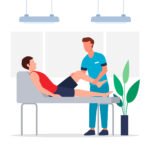Understanding the Locking and Unlocking of the Knee Joint: Mechanism, Muscles, and Clinical Importance
The locking and unlocking of the knee joint is one of the most fascinating biomechanical processes in the human body. This unique mechanism allows us to stand upright for long periods without excessive muscle fatigue and provides stability while walking, running, or jumping. For athletes, active individuals, and those recovering from knee injuries, understanding this process is crucial for maintaining optimal knee health.
In this article, we’ll dive deep into the knee locking and unlocking mechanism, the role of the locking muscle of the knee joint, causes of knee unlocking problems, and how modern orthopaedic care addresses related issues.
What is the Locking and Unlocking of the Knee Joint?
The locking of the knee joint refers to the process where the knee becomes stable in a fully extended position, requiring minimal muscular effort to maintain. This is particularly useful when standing still, as it reduces the load on thigh muscles.
The unlocking of the knee joint is the process that allows the knee to move from a stable extended position to a bent (flexed) position. This requires coordinated movement between bones, ligaments, and muscles.
The Knee Locking and Unlocking Mechanism Explained
The knee is not a simple hinge joint—it’s a complex structure involving rolling, gliding, and rotation. The works as follows:
- Locking Phase
1. Occurs in the final stages of knee extension.
2. The femur (thigh bone) slightly rotates inward on the tibia (shin bone) due to the shape of the condyles and ligament tension.
3. This movement tightens the ligaments, stabilising the joint.
- Unlocking Phase
1. Initiated by the popliteus muscle, often referred to as the locking muscle of the knee joint (though it technically “unlocks” the knee).
2. The popliteus rotates the femur outward, loosening the ligaments and allowing knee flexion.
Why is the Locking and Unlocking Mechanism Important?
- Stability: Allows you to stand without constant muscle engagement.
- Energy Efficiency: Reduces fatigue during prolonged standing.
- Injury Prevention: Protects the knee from instability and hyperextension.
- Mobility: Ensures smooth transition from standing to walking or running.
Common Problems with Knee Locking and Unlocking
Some people experience difficulty in locking or unlocking their knees. This can happen due to:
- Meniscus Tears: Damage to the cartilage may block normal joint movement.
- Ligament Injuries: ACL, PCL, or MCL injuries affect stability.
- Popliteus Dysfunction: Weakness or strain in the locking muscle of the knee joint affects unlocking.
- Arthritis: Joint stiffness reduces smooth locking-unlocking.
- Loose Bodies: Bone or cartilage fragments can interfere with joint movement.
Treatment Approaches
- Physiotherapy: Strengthening the quadriceps, hamstrings, and popliteus.
- Medical Management: Anti-inflammatory medications to reduce swelling.
- Minimally Invasive Surgery: Arthroscopy for meniscus repair or ligament reconstruction.
- Lifestyle Modifications: Weight management and low-impact exercises.
Preventing Knee Locking Issues
- Strength Training: Focus on quadriceps, hamstrings, and calf muscles.
- Stretching: Improves flexibility and reduces stiffness.
- Proper Footwear: Reduces stress on the knee joint.
- Avoid Sudden Twists: Especially in sports like football, basketball, or badminton.
- Regular Checkups: Early detection prevents long-term complications.
About Dr. Aniket Patil – Expert in Knee Care, Kharadi, Pune
Dr. Aniket Patil is a highly skilled Orthopaedic Surgeon in Kharadi, Pune, specialising in sports injuries, joint care, and arthroscopic procedures. His expertise covers locking and unlocking of the knee joint, treating patients with knee locking and unlocking mechanism disorders, knee unlocking problems, and injuries involving the locking muscle of the knee joint. With advanced diagnostic tools, personalised care, and minimally invasive treatments, Dr. Patil ensures patients regain mobility, stability, and confidence in their movement.
Tags-: locking and unlocking of knee joint in kharadi, knee locking and unlocking mechanism in kharadi, knee unlocking in kharadi, locking muscle of knee joint in kharadi, locking and unlocking of knee joint in pune, knee locking and unlocking mechanism in pune, knee unlocking in pune, locking muscle of knee joint in pune, locking and unlocking of knee joint doctor in pune, locking and unlocking of knee joint doctor in kharadi
Frequently Asked Questions (FAQs)
Ans. It is caused by a combination of bone rotation, ligament tension, and muscle activation. The locking occurs due to inward femoral rotation, and unlocking is initiated by the popliteus muscle.
Ans. The popliteus muscle is responsible for unlocking the knee joint by rotating the femur outward from the tibia.
Ans. Yes. Persistent locking may indicate meniscus tears, ligament damage, or loose cartilage in the joint and should be evaluated by an orthopaedic specialist.
Ans. Strength training, stretching, avoiding sudden twisting movements, and wearing proper footwear can help prevent knee locking issues.
Ans. Pain during knee unlocking may be due to underlying injuries or arthritis and should be examined by a doctor to avoid worsening the condition.

 Previous Post
Previous Post Next Post
Next Post